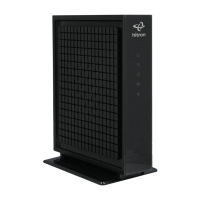Version 1.1, 08/2013. Copyright 2012 Hitron Technologies
49
Version 1.1, 08/2013. Copyright 2013 Hitron Technologies
49
Hitron CGN3 User’s Guide
By default, computers on the WAN cannot identify individual computers on the LAN;
they can see only the CGN3. The CGN3 handles routing to and from individual
computers on the LAN.
4.1.2 LAN IP Addresses and Subnets
IP addresses on the LAN are controlled either by the CGN3’s built-in DHCP server
(see
LAN Settings on page 28), or by you (when you manually assign IP addresses to
your computers).
For more information about IP addresses and subnets in general, see LAN Settings
on page 28.
4.1.3 DNS and Domain Suffix
A domain is a location on a network, for instance example.com. On the Internet,
domain names are mapped to the IP addresses to which they should refer by the
Domain Name System. This allows you to enter “www.example.com” into your
browser and reach the correct place on the Internet even if the IP address of the
website’s server has changed.
Similarly, the CGN3 allows you to define a Domain Suffix to the LAN. When you
enter the domain suffix into your browser, you can reach the CGN3 no matter what IP
address it has on the LAN.
4.1.4 Debugging (Ping and Traceroute)
The CGN3 provides a couple of tools to allow you to perform network diagnostics on
the LAN:
Ping: this tool allows you to enter an IP address and see if a computer (or other
network device) responds with that address on the network. The name comes
from the pulse that submarine SONAR emits when scanning for underwater
objects, since the process is rather similar. You can use this tool to see if an IP
address is in use, or to discover if a device (whose IP address you know) is
working properly.
Traceroute: this tool allows you to see the route taken by data packets to get
from the CGN3 to the destination you specify. You can use this tool to solve
routing problems, or identify firewalls that may be blocking your access to a
computer or service.

